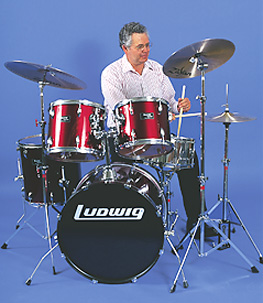Drum is one of the oldest musical instruments. It is a member of the percussion family, which consists of instruments that are played by striking them with the hand, sticks, or other objects. Drums have also been used for various nonmusical purposes. For example, people of many cultures have used drums to communicate over long distances.

The shell (body) of a drum may be shaped like an open cylinder or a kettle. A thin covering called a drumhead is stretched tightly across the opening. Drumheads may be made of either calfskin or plastic. A cylinder-shaped drum generally has two drumheads. A kettle-shaped instrument has one.
Loading the player...Drum set
A musician strikes the drumhead with sticks, with mallets, or with the hand to create vibrations that produce a sound. This sound resonates (increases) inside the shell of the drum.
Loading the player...Japanese taiko drumming
The three most popular types of drums are the snare drum, the bass drum, and the timpani. Only the timpani can produce definite musical notes. The other types are used primarily as rhythm instruments.
The snare drum consists of a metal or wooden cylinder with a drumhead covering each opening. The drumhead used for playing is called the batter head. The opposite one is called the snare head. About 12 gut or wire strings called snares stretch across the snare head. A drummer strikes the batter head with two wooden sticks. The snares vibrate against the snare head, producing a full, crisp sound.
The bass drum resembles a large snare drum. The drumhead used for playing is called the beating head, and the opposite one is called the resonating head. At times, the drummer may play both heads at the same time. The drummer uses mallets to create a deep, booming sound. Various tone colors can be produced by using felt, wool, or wooden mallets.
The timpani are played in pairs or in groups of four. The drum is shaped like a kettle and is often called a kettledrum. It consists of a large copper or fiberglass shell with a single drumhead. A pedal mechanism enables the player to tune the drum to different pitches. Timpani produce a deep, resounding tone achieved by striking the drumhead with mallets. Different tone colors may be obtained by using a variety of mallets made of soft felt, hard felt, or wood.
